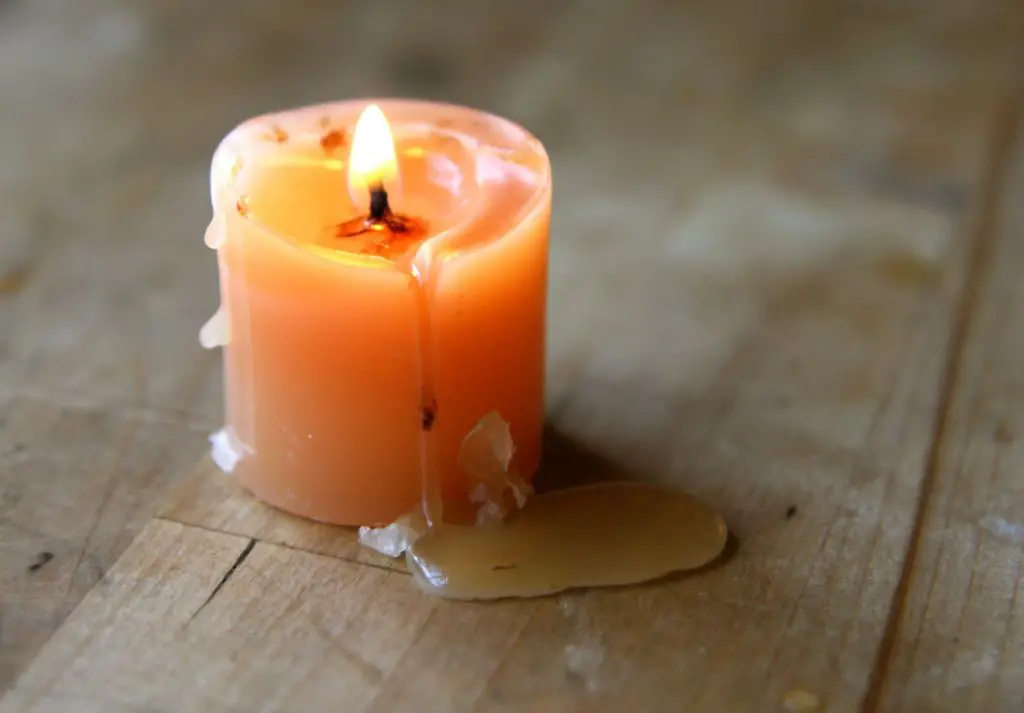Does Wax Burn Or Evaporate?
Wax is a common household material, used in products like candles and crayons. It is composed of hydrocarbons and has a low melting point, which allows it to liquefy when heated. This results in unique properties – wax can transition between solid and liquid states under normal temperatures.
When a candle burns, the solid wax melts and transforms into a liquid fuel source. But there is an interesting question around what exactly happens to the wax itself. Does the wax undergo combustion when a candle burns? Or does the wax simply evaporate, turning from liquid back into a gas? This article will explore the chemistry behind burning candles, analyzing whether wax truly burns or evaporates.
Chemical Composition of Wax
Wax is made up of long-chain hydrocarbons, which are molecules composed of carbon and hydrogen atoms linked together in chains. The hydrocarbon chains in wax typically have between 20 and 40 carbon atoms. The length of the chains and the amount of branching determines the physical properties of the wax, including its melting point and hardness. Different types of wax have slightly different chemical compositions based on the source of the wax. Beeswax, for example, contains some oxygenated compounds like esters and fatty acids, in addition to hydrocarbons. Paraffin wax is made up of mostly straight-chain hydrocarbons, while microcrystalline wax has some branching. But all types of wax derive their key properties from their long hydrocarbon chains [1].
Melting Point of Wax
Wax has a relatively low melting point compared to many other materials. The melting point of wax commonly used in candles ranges from about 120-185°F (48-85°C), with most falling between 125-165°F (52-74°C) (source). This allows the solid wax to transform into a liquid when heated to those moderate temperatures. By comparison, substances like lead, zinc, and aluminum have melting points of over 600°F (315°C). The low melting point enables wax to liquefy quickly with the heat of a candle flame. As the melted wax pools around the wick, capillary action keeps drawing the liquid wax up, feeding the flame.
Does Wax Burn?
Yes, wax can undergo combustion reactions with oxygen to burn and give off heat and light. Wax is made up of hydrocarbons like paraffin, which contain carbon and hydrogen atoms bonded together. When supplied with enough heat and oxygen, the hydrocarbon molecules in wax can react with oxygen in a combustion reaction. This releases energy in the form of heat and light, which we observe as burning. However, pure paraffin wax has a relatively low melting point between approximately 115-160°F. This means the wax usually melts into a liquid before reaching high enough temperatures for burning to occur.
According to sources, “When you light the wick, it starts to heat up the wax which quickly becomes a liquid. As a liquid, the wax gets drawn up the wick where it vaporizes and burns.”(Source) While the wax itself does not directly sustain a flame, the heat from the burning wick vaporizes and breaks down the wax molecules into combustible gases that burn.
Does Wax Evaporate?
Yes, wax can evaporate directly from the solid or liquid state into a vapor below its boiling point. This process is known as sublimation and evaporation. The rate of evaporation increases as temperature rises.

When wax is heated, such as by a candle wick, the heat provides energy for individual wax molecules to overcome intermolecular forces and escape from the liquid or solid surface as a vapor. This vaporization occurs progressively, with wax molecules constantly leaving the surface until the fuel source is depleted.
According to a chemistry discussion on Reddit, waxes like paraffin are composed of alkane hydrocarbons with high molecular weights. Their intermolecular van der Waals forces are relatively weak, allowing the hydrocarbon molecules to evaporate at lower temperatures compared to water, for example. The vapor pressure, which indicates evaporativity, increases exponentially with rising temperature for wax.[1]
So in summary, wax can evaporate without reaching its boiling point, through sublimation from the solid state or evaporation from the melted liquid state. This occurs continuously when wax is exposed to heat, like from a candle flame. The rate of evaporation, and loss of wax, accelerates significantly at higher temperatures.
[1] https://www.reddit.com/r/askscience/comments/4mq2us/chemistry_does_wax_evaporate/
Wick Burning
A wax candle burns through a process called capillary action. The solid wax melts into a liquid from the heat of the flame. This liquid wax is then drawn up the wick by capillary action, which is the ability of a liquid to flow upward in narrow spaces. As the liquid wax moves up the wick, it reaches the flame and vaporizes. The heat of the flame turns the liquid wax into a hot gas or vapor. This wax vapor then undergoes combustion or burning in the flame (source).
The porous and fibrous structure of the wick acts like a straw, drawing the liquid wax upward. The heat of the flame at the top of the wick provides the energy to vaporize the liquid wax into a gas. It is this wax vapor that actually burns to produce the flame. The flame vaporizes more liquid wax, sustaining the capillary action in a loop (source). This capillary action processrepeats continuously until the wax fuel source is depleted and the candle can no longer burn.
Candle Wax Pool
When a candle burns, the flame melts the solid wax surrounding the wick into a liquid pool. According to suffolkcandles.co.uk, as the wax melts and pools around the wick, instead of travelling downwards, the wax actually travels upwards through the candle’s cotton wick. The melted wax is then vaporized by the flame through a process called capillary action.
The wax pool is an important part of how a candle burns. The melted wax provides fuel for the flame via the wick. Some wax evaporates due to the heat while the rest is drawn up the wick where it vaporizes in the flame. This evaporation and burning of wax sustains the flame and allows the candle to continue burning. The size and temperature of the wax pool impacts the burn rate – a hotter, larger pool will cause faster evaporation and burning of the wax.
Proper wax pool size is important for efficient candle burning. If the pool is too small, the flame can tunnel down through the wax. Too large of a pool can cause the candle to burn too quickly or produce more soot. Ideal pool size depends on the candle diameter but is typically 1/4 to 1/2 inch deep.
Factors Affecting Burning
There are several factors that can affect the burning and evaporation processes of candle wax, including the type of wax used, the temperature, and air currents.
The type of wax used in a candle can significantly impact how it burns. Common types of candle wax include paraffin, soy, beeswax, and gel wax. Paraffin wax, made from petroleum, melts at a lower temperature and burns brighter and hotter than natural waxes like soy and beeswax. It also releases more soot as it burns. Natural waxes like soy and beeswax have higher melting points and burn cooler and slower than paraffin. Gel wax contains mineral oil so it burns even slower and cooler than other waxes.1
Temperature also plays a key role. If the ambient temperature is too low, the wax may solidify before it has a chance to fully evaporate. At higher temperatures, the wax melts quicker and evaporates faster as the candle burns. Breezy conditions can accelerate evaporation while stagnant air will slow the process. Keeping candles away from drafts helps the wax pool properly as the candle burns.2
Overall, the type of wax, temperature, and air currents all impact the evaporation and burning rates of candle wax. Paraffin wax in warmer conditions with moving air will burn and evaporate the quickest while beeswax in a cool, still room will have the slowest burn.
Burning vs Evaporation
Wax burning and evaporation occur simultaneously while a candle is lit, but at different rates depending on the type of wax and conditions. Paraffin wax, a commonly used candle wax, melts at around 130-150°F and evaporates more quickly than it burns. Beeswax has a higher melting point around 143-170°F, so it tends to burn at a faster rate than paraffin before evaporating. Soy wax and palm wax also evaporate more slowly than paraffin due to their higher melting points.
The relative humidity of the environment affects evaporation rates. Higher humidity slows evaporation, while drier conditions promote faster evaporation. This means candles will burn faster compared to evaporation in humid conditions, while they evaporate quicker in arid environments. Air current around the candle can also increase evaporation.
A larger flame melts more wax so burning occurs faster than evaporation. But if the wick is too short or the wax pool becomes too deep, the flame may be deprived of oxygen resulting in more evaporation. Properly trimming the wick helps ensure steady burning versus evaporation.
In summary, paraffin and other waxes with lower melting points tend to evaporate faster than beeswax or soy/palm waxes. Humidity, air currents, and flame size also affect the relative rates of burning versus evaporation in candle wax.
Conclusion
In summary, wax can both burn and evaporate during the candle burning process. While technically different phenomena, burning and evaporation are interconnected in candle wax. When a candle is lit, the heat from the flame melts the solid wax into a liquid state. The wick then draws the liquid wax up via capillary action and the liquid fuel vaporizes at the flame. Here, the wax undergoes evaporation as it transitions from a liquid to a gas. The wax vapor then mixes with oxygen and combusts in the flame, producing light, heat, water vapor, and carbon dioxide. This burning process sustains the evaporation of more liquid wax into vapor. Therefore, the evaporation of wax enables its continued burning in the candle flame. The relative extent of burning versus evaporation depends on factors like wax composition, flame temperature, and burn environment. But fundamentally, both processes are essential parts of how candles work.





